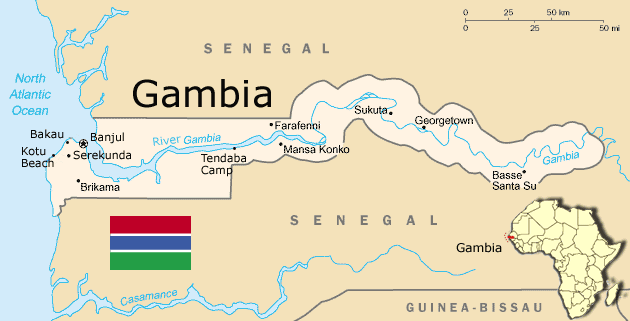 |
| |
| |
 |
|
Information about
Gambia
Gambia is a small country surrounded by Atlantic
Ocean and Senegal and have strong ethnic and cultural ties to
the country.
As Senegal was a former French colony, The Gambia was colonized by
Great Britain and gained it's Independence on February 18,
1965, and has enjoyed long periods of peaceful times ever
since.
Gambia has limited resources but a high
concentration of birds, so agriculture and farming with light
manufacturing and tourism make up the economy.
Gambian people are friendly, they like music and football,
and have an unhurried way of life.
|
|
| |
|
|
|
|
| |
FACTS
Full country name: Republic of The Gambia
Population: 1.5 million (UN, 2005)
Capital: Banjul
Area: 11,295 sq km (4,361 sq miles)
People: Mandinka (42%), Fula (18%), Wolof (16%), Jola (10%), Serahuli (9%), other African (4%), non-Gambian (1%)
Language: English (official), Mandinka, Wolof, Fula, other indigenous languages
Religion: Muslim (90%), Christian (9%), indigenous beliefs (1%)
Government: Republic under multiparty democratic rule
Life expectancy: 54 years (men), 57 years (women) (UN)
Monetary unit: 1 dalasi = 100 butut
Main exports: Peanuts and peanut products, fish, cotton lint, palm kernels
GNI per capita: US $290 (World Bank, 2005) |
|

|
|
| |
|
|
|
|
| |

The Flag: the blue stripe symbolizes the river Gambia, which flows between the
green forest and the red savannah.
White stands for unity and peace. |
|
| |
|
|
|
|
| |
History
The first written accounts of the region come from records of Arab traders in the 9th and 10th centuries AD. Tekrur, a kingdom centered on the Senegal river just to the north, were the first black African people to convert to Islam, in 1066. Muslim traders established the trans-Saharan trade route for slaves, gold, and ivory.
During the late 17th century and throughout the 18th, England and France struggled continuously for political and commercial supremacy in the regions of the Senegal and Gambia Rivers.
As many as 3 million slaves may have been taken from the region during the three centuries when the transatlantic slave trade operated.
After World War II, the pace of constitutional reform quickened. Following general elections in 1962, full internal self-government was granted in 1963. The Gambia achieved independence on February 18, 1965. |
|

|
|
| |
 |
|
Economy
The
Gambia has a liberal, market-based economy characterized by
traditional subsistence agriculture, a historic reliance on
groundnuts (peanuts) for export earnings, a re-export trade
built up around its ocean port, low import duties, minimal
administrative procedures, a fluctuating exchange rate with no
exchange controls, and a significant tourism industry.
Each tourist should buy services from the local people and NOT totally
rely on the tour operator services which are foreign financed. This ensures that some of the money you spend directly enters the local
economy!
|
|
| |
Politics
Before
the coup d'état
in July 1994,
The Gambia was one of the oldest existing multi-party
democracies in Africa. It had conducted freely contested
elections every 5 years since independence. After the military
coup, politicians from deposed President Jawara's People's
Progressive Party (PPP) and other senior government
officials were banned from participating in politics until
July 2001.
In July 1994, the Armed Forces Provisional Ruling Council
(AFPRC) seized power in a military coup d'etat, deposing the
government of Sir Dawda Jawara. Lieutenant Yahya
A.J.J. Jammeh, chairman of the AFPRC, became head of
state. The AFPRC announced a transition plan for return to
democratic civilian government.
|
|

President Yahya Jammeh
|
|
| |
 |
|
Nature
The country's
landscape is so flat that in the Gambia River's 450km (280mi)
meandering course, it drops in elevation only about 10m
(30ft). In the lower estuary, mangroves dominate the
riverside, with extensive reed belts in the in-between zone,
while where the water is fresh, the banks are lined with
gallery forest. Away from the river, The Gambia's position in
the southern Sahel, a semi-arid region south of the Sahara
desert, means natural vegetation is more or less limited to
dry grassland and open savanna.
|
|
| |
The country is less
than 48km wide and 300km long, with a total area of 11,300 km².
Its present boundaries were defined in 1889 after an
agreement between the United
Kingdom and France. It is
almost an enclave of Senegal
and the smallest country on the continent of Africa.
A wide variety of ethnic groups
live in The Gambia with a minimum of intertribal friction,
each preserving its own language and traditions.
More
than 63% of Gambians live in rural villages (1993 census),
although more and more young people come to the capital in
search of work and education. The gap between the urban and
rural populations is narrowing as more areas are declared
urban. While urban migration, development projects, and
modernization are bringing more Gambians into contact with
Western habits and values, the traditional emphasis on the
extended family, as well as indigenous forms of dress and
celebration, remain integral parts of everyday life.
|
|

|
|
| |
 |
|
Wild life
Over 600 species of
bird have been recorded in Gambia, very large number for such
a small country. Abuko Nature Reserve was said to be the best
place to go looking for them, but there are five other
national parks and reserves where the fauna is equally
plentiful. We saw some birds there and on the Tendaba boat
trip; herons, ibises, king fishers, vultures, pelicans and
others. The River Gambia National Park is the place to see
monkeys and chimpanzees; Abuko Nature Reserve is also a good
reserve to see monkeys.
(info source Wikipedia) Back up
|
|
| |
 |
|
 |
|

